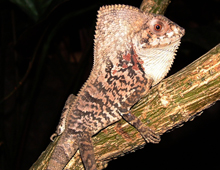Description: The casque or helmet of the Helmeted basilisk is triangular and supported at the back by a projection of the parietal bone (located at the back of the head). The canthus (corner or angle at either side of the eye) raises into a sharp ridge, extending as an arch over the eyes and then back. The casque continues as a vertical crest onto the shoulders. A gular (situated on the throat) flap extends from below the chin. The limbs and tail are long and slender. Coloration varies from tan, brown, to green with irregular spots and bands. They use their ability to change color (light or dark) depending which helps in thermoregulation while basking in the sun.
Size: Adult Helmeted basilisks reach four to five inches (10.5-12.5 cm) in SVL (snout-vent length) and a total length of 14-15 inches (35-39 cm). There is little or no sexual dimorphism in size but the crest may be somewhat larger in males.
Behavior: Helmeted basilisks use their cryptic color pattern as a defense, usually remaining motionless on a vertical limb. When threatened, they increase their apparent size by stiffening their legs to raise their body, depresses the head in order to raise the crest and expands the throat fan. Head-bobbing, forward lunging and biting are also used if necessary. Helmeted basilisks sit and wait for their prey, feeding mostly on large insects.
They are not particularly agile but can move quickly for short distances by using an awkward-appearing bipedal hop.
Diet: Helmeted basilisks sit and wait for their prey, feeding mostly on large insects.
Reproduction: Five to eight eggs are laid in a shallow nest on the forest floor. The leathery eggs are 0.8 – 1 inch (2-2.5 cm) in length and weigh 0.07-0.1 ounce (2- 2.8 gr). The eggs more than triple in weight before hatching.
Habitat/range: Helmeted basilisks inhabit dry, moist and wet forests and subtropical wet forests. They are common in the Yucatan and range from Veracruz to Panama.
Status: Listed as Least Concern by IUCN.



